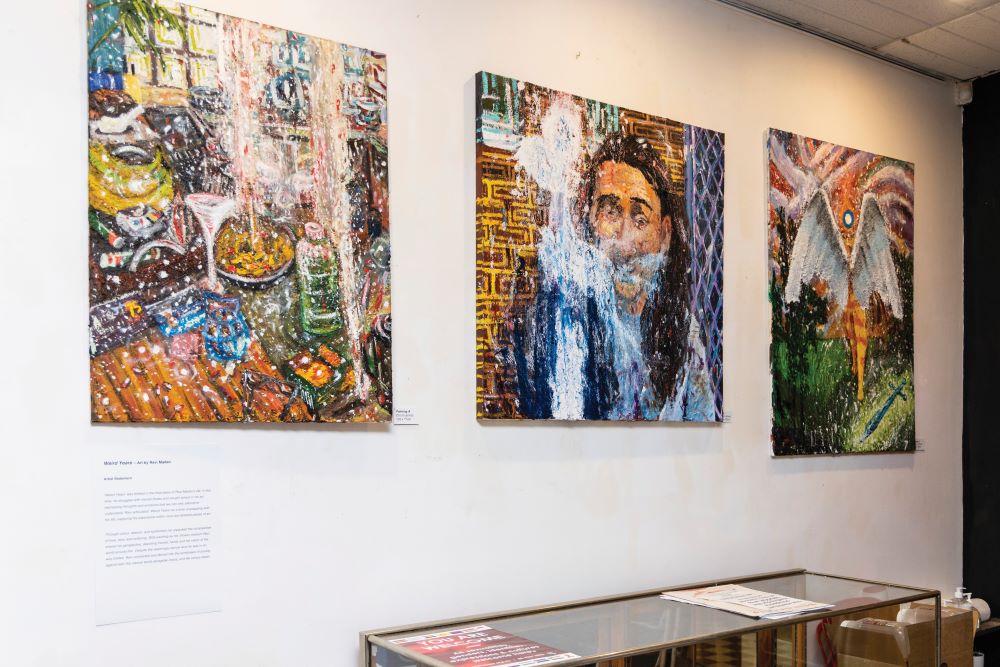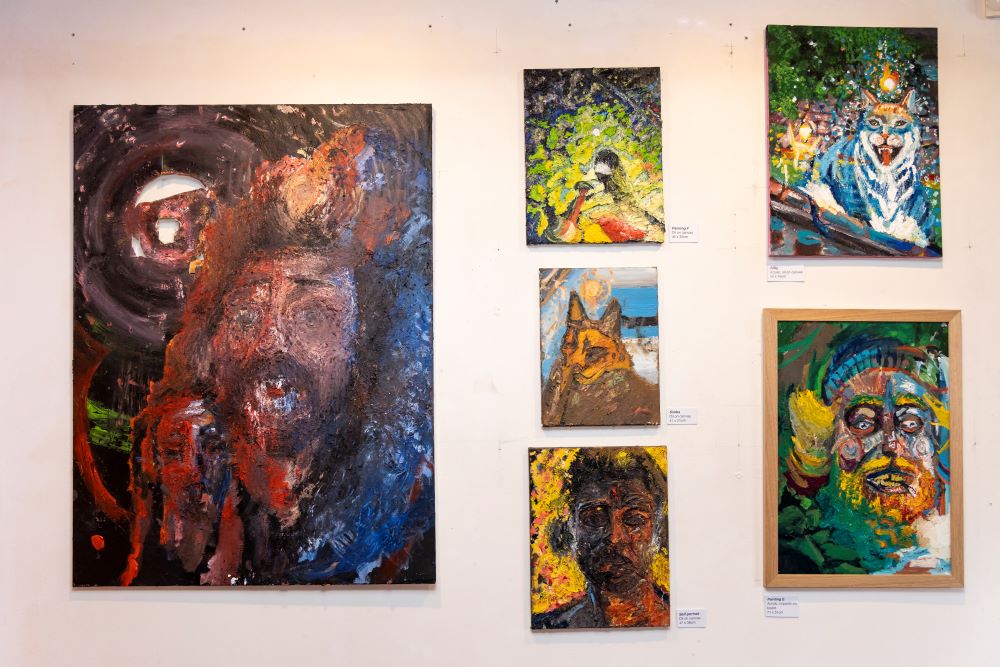Love, family, friendship, turmoil, and a life lost too soon are all themes explored in Weird Years, on at Smith’s Alternative until late January. The paintings created by local artist Ravi Madan tell his story, one that his parents are hoping will help reshape the way we approach mental health care in the ACT.
Ravi was only 23 years old when he took his own life in April 2021 after a struggle with mental illness and spending time in and out of care facilities. Now, his parents are fighting to change how families and carers are treated during mental health episodes, so no other family has to lose their child.
The talented young artist is remembered as an old soul who was charming, funny, intelligent, handsome, and a bit cheeky.
“He would ask questions; in fact, at a Catholic primary school he questioned the bishop, he questioned him on a point of order,” smiles Leigh Watson, Ravi’s mother.
Ravi’s father, Ashish Madan, and Leigh have been campaigning since they lost their son. While they appreciate the care Ravi received, they believe that more could have been done to help support not only Ravi, but to guide them as parents on how to support their child.
Self-taught, Ravi showed an interest in art from an early age. Leigh recalls back when she was a stay-at-home mum, her go-to activities for Ravi and his sister were creative endeavours. Even though she says she isn’t artistic, it seemed like something easy; she would look for ways to switch it up by adding sand for texture and the like.
“Whenever I was running out of things to do with them, that was it. So, we had big easels everywhere and butcher’s paper,” Leigh says.
Ravi’s passion for art and painting continued throughout his school years and into adulthood. In his final years, he was working with his friend Brooke Nielsen Richardson, who was studying curation at university, towards putting on an exhibition. After his passing, Brooke worked with Leigh and Ashish to curate Weird Years, with 15 original artworks chosen from the walls of the family home.
Hindsight being 20/20, Ravi’s parents say they try not to obsess over when he first showed signs of potential mental illness, thinking that he was going through teenage angst, and that he would come into his own when he went to university. They say this strategy worked well during his first year living on campus.
“He was a different person; he was his own person, and we didn’t want to spoil that by highlighting it or by getting him a counsellor. But I guess his first suicide attempt was when it was really clear to us,” says Leigh.
Throughout the two-and-a-half-year struggle, Ravi stayed in mental health units at both public and private facilities. Leigh believes that there wasn’t a lot of effort put into reaching a diagnosis or a succinct treatment plan. She says they were never involved as parents; not one person asked about Ravi’s homelife, childhood, or when he started to show signs that something wasn’t right.
“It seems the first person who ever saw him put with a question borderline personality disorder, not with an actual question mark just with the way it was worded. Then ever since then, people have just read that and taken it as read,” Leigh says.


But for them it wasn’t the diagnosis that was important, it was the prognosis. How could they better help their son when he returned home, what does his future look like and what steps should they be taking to ensure Ravi would be safe?
“What’s the prognosis, how long is this going to last? What do we need to do better? Say in years to come down the track when we aren’t here, do we have to do anything to make sure he is financially stable?” says Ashish.
However, as Ravi was over the age of 18, no one could talk with them about his mental state without Ravi’s permission, something he didn’t give.
“Once you are 18, the system doesn’t seem to want to talk to the carers; that’s where there is a big gap in which they will not talk to you. If you ring them up and say what is the diagnosis, prognosis, they can’t talk to you about it,” Ashish says.
The concerned parents kept fighting for someone to talk to them about what was going on in their son’s life, someone to explain it to them and to help them. The couple say all these calls fell on deaf ears. Eventually, a much sought-after meeting with a psychiatrist treating Ravi, still did not provide them with the information they were seeking that could help them support their child.
From there, things took a downhill turn; at no stage did they receive any guidance, and their one chance to gain insight was wasted. They learned that Ravi was telling people during his in-care that his family home was a toxic environment, and are still seeking answers as to why no one took the steps to verify that information.
The couple are recommending that the system recognise this gap and take steps to involve the carers, the people who will be living with and interacting with the patient. They have outlined recommendations they believe could help other families, including a family peer support program following an attempted suicide. A support worker would ensure the family is provided with relevant information in a format they could understand, and guidance on how to navigate the mental health system.
The other program would see a suicide prevention case worker for the young person who has attempted to take their life. They would work with them to develop a relationship and guide them through reintegrating into the community, reaching out for medical treatments, and finding employment.
“We are looking for positive change to the system so that other people don’t actually suffer in their journey to get well. We need to get people on board with what is happening,” says Ashish.
The family is pleased that the ACT Government and the community sector have been willing to hear about their experience. While there has been some movement in certain areas they have highlighted, they will continue to advocate until they see broad reform as outlined in their recommendations.
“Focus by the means of support to integrate the person who is not well back into the community, back into the family to make sure their needs are being met,” says Ashish.
“There is broad understanding by those working in the sector, including at leadership level, that the system needs to improve. This includes both hospital services and those provided by the community,” says Leigh.
See the art of Ravi Madan in Weird Years at Smith’s Alternative until late January; or see more of Ravi’s work online at facebook.com/Ravistribute
If this story has raised concerns, help is available. Call or visit the website of Lifeline (13 11 14) or Beyond Blue (1300 22 4636). In an emergency, call 000.
Get all the latest Canberra news, sport, entertainment, lifestyle, competitions and more delivered straight to your inbox with the Canberra Daily Daily Newsletter. Sign up here.


